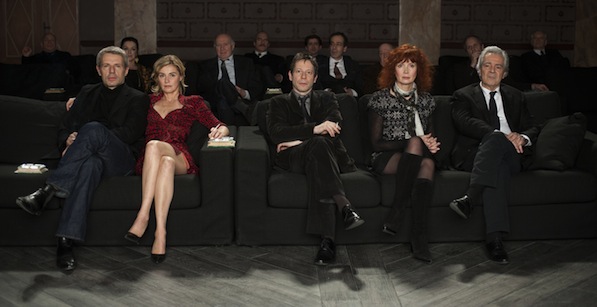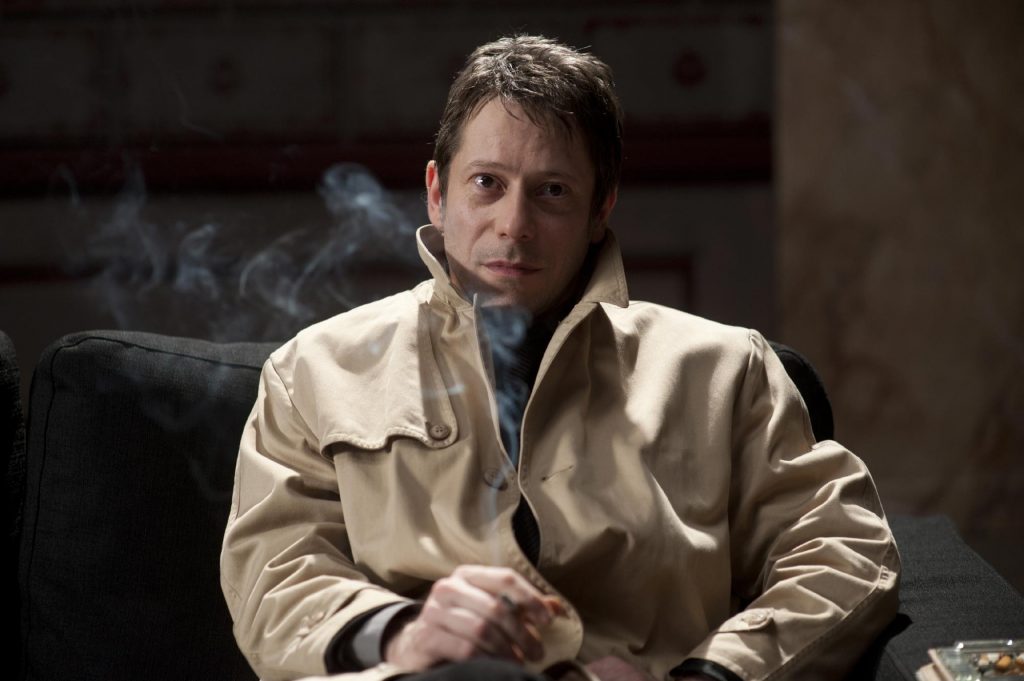From the way some have been discussing Alain Resnais’ last release, you might have thought of it to be his last. But as the title makes clear that’s far from the case. Adapted from two Jean Anouilh plays, it concerns a famous playwright and his apparently postmortem request that his favorite actors gather at his palatial home to see a video presentation of his most famous play, Euryidice, to pass their approval on a new production of it. And as the actors are part of the company Resnais has utilized since the seventies (Pierre Arditi, Sabine Azéma, Lambert Wilson) plus a few notable newcomers to le monde Resnais (Michel Piccoli, Mathieu Almaric) a kind of autumnal valedictory work might be expected from the ninety one-year-old grand cinematic master. But You Ain’t Seen Nothin’ Yet (Vous n’avez encore rien vu) is far more playful than autumnal for it takes the highly idiosyncratic style of “filmed theater” that Resnais has trafficked in over the past twenty seven years beginning with Melo (from Henry Bernstein’s twenties-era play in 1986) and continuing on with Smoking/No Smoking (a suite of Alan Ayckbourn plays re-conceived as a “two-hander” for Arditi and Azema in 1993), Not on the Lips (a 1920’s comic “operetta” in 2003), Private Fears in Public Places (another Ayckbourn comedy-drama in 2006) and takes it to a new level. For rather than film Anouilh head-on, Resnais atomizes him though a mise en scene whose visual and dramatic complexity recalls such earlier works as Muriel (1963) and Je t’aime Je t’aime (1968), Mon Oncle d’Amerique (1980), La Vie est un Roman (1983) and above all Providence (1977) which also deals with a writer’s relation to the fictional world he has created.
The writer in that film (embodied physically and a fortiori aurally by John Gielgud) was very much front and center throughout—as an aged, dying writer, analyzing a work right in the midst of the creative process. Here we’re informed at the very start that the mysterious Antoine d’Anthac has died, and that his last wish was that his favorite actors be assembled at his palatial home (Jacques Saulnier as usual created the stunning production designs) to view a video made by a group of young actors planning to stage a new production of Euryidice. If the author’s favorite actors approve the production will go forward. But making any sort of judgment takes a back seat to the actors’ responses as, seemingly inspired by the novice’s work they launch into scenes from Euryidice on their own. It’s as if the work itself had somehow become unmoored. This is made especially clear when the screen is divided in two showing Pierre Arditi and Lambert Wilson to playing Orpheus at the same time. And then, to give the film’s title yet another twist the supposedly deceased suddenly enters to add his two cents. The question of why this pretense of death was engineered quickly takes a back seat to the fact that this presumably aged author is played by quite a young man, Denis Podalydès—whose brother Bruno was given a free hand by Resnais to shoot the film-within-the-film of the young actors performing Euryidice however he wanted.
So what, might well ask, is Resnais getting at in all of this? Clearly this is a film about his love of actors. As each of them does a bit from the play-within-the-film in a different style we witness an object lesson in what actors can do on both stage and screen. At the same time the play itself, by its very nature, is a confrontation with mortality. Orpheus longs for the dead Euryidice but can only “see” her if he doesn’t look at her, for doing so would take her away from him again—clearly a fate worse than death. Yet for all this romantic fatalism we’re shown at the very end a scene in which Antoine d’Anthac appears to drown himself. Is that what’s “actually happened” or is Resnais pulling our leg once again. In any even without changing its key from Mark Snow’s subtle score we suddenly hear Frank Sinatra intoning his autumnal cri de coeur “It Was a Very Good Year.”
Come again?
It’s hard to imagine how a movie-going public resistant to seeing anything more complex that Les Miz, is going to cotton to a film like this. But if it’s only “for the happy few,” so be it. Resnais after all is hard at work at his next, another Ayckbourn adaptation re-titled Aimer, Boire, Chanter. Perchance that will end with “The Chairman of the Board” doing “My Way.”






